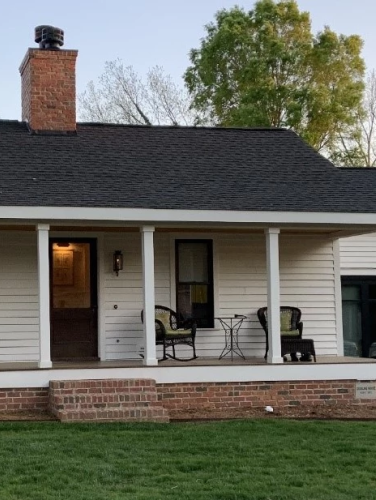
Delburg Cotton Mill House
(ca. 1916)
The Delburg Cotton Mill House is a visible reminder of the class stratification prompted by southern industrial development.
303 Delburg St, Davidson, NC 28036
The opening of the Delburg Cotton Mill in 1907, and its 1917 expansion, represented the apex of Davidson’s industrial development. Industrialization first reached the small college town in 1890 when the Linden Cotton Mill opened on the west side of the railroad. As the new century approached, the Linden Mill was followed in rapid succession by a flour mill, sawmill, roller mill, fertilizer plant, and ice plant, all located on the west side of town. Some 2,000 bales of cotton were also bought and sold annually in town by the beginning of the 20th century. Long lines of wagons loaded with raw cotton for ginning into 500-pound bales traveled down Main Street and Concord Road to a ginnery near the South Main Street cotton oil plant. Davidson’s industrial facilities drastically changed the town’s landscape, and the introduction of a non-agricultural blue-collar workforce significantly changed the social dynamics of the community, rivaling Davidson College in terms of its presence and prominence.
Property Quick Links
While the expansion of the Delburg Mill greatly increased the facility’s size, it also expanded the town’s overall industrial capacity and workforce. That growth included the orderly development of a mill village along Delburg and Watson Streets for the additional workers needed for the larger mill. Numerous small frame mill houses were erected adjacent to the mill between 1916 and 1921. The Delburg Cotton Mill House, located just 60 feet from the Delburg addition, is one of the best preserved examples of that generation of mill houses. With two cotton mills and various other industrial operations nearby, the Delburg Cotton Mill village solidified the blue-collar character of Davidson’s industrial west side.
In late-19th century Davidson, like most other rural North Carolina communities, White residents were jumbled together. Regardless of wealth or social rank, they generally lived near each other and worked and worshiped together. Davidson’s new manufacturing facilities changed all that. As mill populations increased, social divisions between middle-class and working-class Whites grew. In addition to the typical southern town class division between mill workers and a merchant class, Davidson had the added distinction of a “town and gown” split. With a significant number of citizens who worked for Davidson College and possessed an advanced education, the cultural, social, and economic differences among the town’s elites and the mill workers were quite distinct.
By 1920, Davidson had become a socially and geographically segregated town. Mill workers were housed to the west of the railroad tracks around the two cotton mills. Other White residents (including college faculty, merchants, and boarding house operators) generally lived east of the tracks. African American residents lived along Brady’s Alley to the east of the tracks, and to the west of the mill housing around Mock Circle. The Delburg Cotton Mill House provides a unique window into the distinct daily lives of Davidson’s mill workers.

